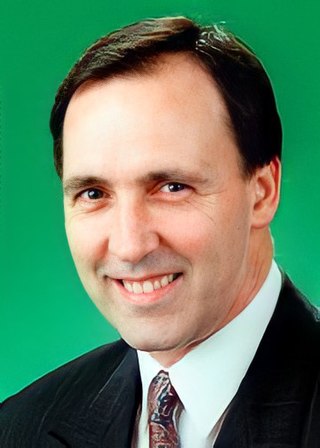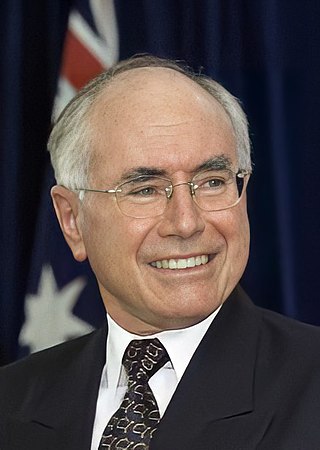Related Research Articles

The Liberal Party of Australia is a centre-right political party in Australia. The party is one of the two major parties in Australian politics, the other being the Australian Labor Party. The Liberal Party was founded in 1944 as the successor to the United Australia Party, and has since become one of the most successful political parties in Australia's history, although currently do not hold government on mainland Australia.

Paul John Keating is an Australian former politician and trade unionist who served as the 24th prime minister of Australia, from 1991 to 1996, holding office as the leader of the Australian Labor Party (ALP). He previously served as the 30th treasurer of Australia in the Hawke government from 1983 to 1991 and as the 7th deputy prime minister of Australia from 1990 to 1991.

Andrew Sharp Peacock was an Australian politician and diplomat. He served as a cabinet minister and went on to become leader of the Liberal Party on two occasions, leading the party to defeat at the 1984 and 1990 elections.

Peter Howard Costello is an Australian businessman, lawyer and former politician who served as the treasurer of Australia in government of John Howard from 1996 to 2007. He is the longest-serving treasurer in Australia's history. Costello was a member of parliament (MP) of the Australian House of Representatives from 1990 to 2009, representing the Division of Higgins. He also served as the Deputy Leader of the Liberal Party from 1994 to 2007.

John Robert Hewson AM is an Australian former politician who served as leader of the Liberal Party from 1990 to 1994. He led the Liberal-National Coalition to defeat at the 1993 Australian federal election.

Goods and Services Tax (GST) in Australia is a value added tax of 10% on most goods and services sales, with some exemptions and concessions. GST is levied on most transactions in the production process, but is in many cases refunded to all parties in the chain of production other than the final consumer.

The 1993 Australian federal election was held to determine the members of the 37th Parliament of Australia. It was held on 13 March 1993. All 147 seats of the Australian House of Representatives and 40 seats of the 76-seat Australian Senate were up for election. The incumbent government of the centre-left Australian Labor Party led by Paul Keating, the Prime Minister of Australia, was re-elected to a fifth term, defeating the centre-right Liberal/National Coalition led by Opposition Leader John Hewson of the Liberal Party of Australia, and coalition partner Tim Fischer of the National Party of Australia. This was the first, and to date only, time the Labor Party won a fifth consecutive election.

Peter Keaston Reith was an Australian politician who served in the House of Representatives from 1982 to 1983 and from 1984 to 2001, representing the Liberal Party. He was the party's deputy leader from 1990 to 1993, and served as a minister in the Howard government.

Andrew John Robb is an Australian former politician. He was a member of the House of Representatives from 2004 to 2016, representing the Liberal Party. He served as Minister for Trade and Investment (2013–2016) in the Abbott and Turnbull governments, and also briefly as Minister for Vocational and Further Education in the Howard government in 2007. Before entering parliament, he was the federal director of the Liberal Party and oversaw the party's return to government at the 1996 federal election.
The birthday cake interview was a live interview on Australian television in March 1993 in which Liberal Party Opposition Leader John Hewson was unable to clearly explain to reporter Mike Willesee whether a birthday cake would cost more or less under his proposed tax reforms. It is remembered as contributing to Hewson's unexpected failure as leader of the Coalition to win the federal election that took place ten days later.
The following lists events that happened during 1994 in Australia.
The following lists events that happened during 1992 in Australia.
The following lists events that happened during 1993 in Australia.

Peter William Hendy is a former Australian politician. He was the Liberal member representing the Australian House of Representatives seat of Eden-Monaro in New South Wales from 2013 to 2016. Hendy served as Assistant Minister for Productivity in the First Turnbull Ministry between September 2015 and February 2016; and as Assistant Cabinet Secretary and Assistant Minister to the Minister for Finance from February 2016. Hendy lost his seat in the 2016 federal election to Labor candidate Mike Kelly.

Kenneth Ross Henry is an Australian economist and public servant who served as the Secretary of the Department of the Treasury from 2001 to 2011.

The Howard government refers to the federal executive government of Australia led by Prime Minister John Howard between 11 March 1996 and 3 December 2007. It was made up of members of the Liberal–National Coalition, which won a majority of seats in the House of Representatives at four successive elections. The Howard government commenced following victory over the Keating government at the 1996 federal election. It concluded with its defeat at the 2007 federal election by the Australian Labor Party, whose leader Kevin Rudd then formed the first Rudd government. It was the second-longest government under a single prime minister, with the longest having been the second Menzies government (1949–1966).

The Hawke government was the federal executive government of Australia led by Prime Minister Bob Hawke of the Australian Labor Party (ALP) from 1983 to 1991. The government followed the Liberal-National Coalition Fraser government and was succeeded by another Labor administration, the Keating government, led by Paul Keating after an internal party leadership challenge in 1991. Keating was Treasurer through much of Hawke's term as Prime Minister and the period is sometimes termed the Hawke-Keating government.

The Keating government was the federal executive government of Australia led by Prime Minister Paul Keating of the Australian Labor Party from 1991 to 1996. The government followed on from the Hawke government after Paul Keating replaced Bob Hawke as Labor leader in an internal party leadership challenge in 1991. Together, these two governments are often collectively described as the Hawke-Keating government. The Keating government was defeated in the 1996 federal election and was succeeded by the John Howard's Coalition government.
The early 1990s recession saw a period of economic downturn affect much of the world in the late 1980s and early 1990s. The economy of Australia suffered its worst recession since the Great Depression.

A spill of the leadership of the Liberal Party of Australia took place on March 23, 1993, following the 1993 federal election. The spill was won by incumbent leader John Hewson over former leader John Howard by 47 votes to 30 while backbencher Bruce Reid attracted only one sole vote, presumably his own. For the Deputy leadership Michael Wooldridge won against Peter Costello
References
- ↑ "Henry Thornton". Henry Thornton. Retrieved 8 September 2016.
- ↑ "Reading between the lines - Federal Budget 2003". smh.com.au. 17 May 2003. Retrieved 8 September 2016.
- ↑ "Another over-taxing day for Keating". 5 March 1993. p. 1 – via Trove.
- 1 2 3 "The GST Debate - A Chronology – Parliament of Australia". Aph.gov.au. Retrieved 8 September 2016.
- ↑ "SPEECH BY THE PRIME MINISTER, THE HON P.J. KEATING, MP NATIONAL PRESS CLUB, CANBERRA". pmtranscripts.pmc.gov.au. 15 September 1992. Retrieved 28 December 2020.
- ↑ Abbott, Tony (1 December 2009). "Tony Abbott reveals his Liberal beliefs and how his public and private lives shaped him". The Daily Telegraph. UK. Retrieved 5 June 2010.
- ↑ "Recent Changes" (PDF). www.aierights.com.au. 28 November 2002. Retrieved 28 December 2020.
- ↑ Politics will get you". The Liberals. Episode 5. 1995.